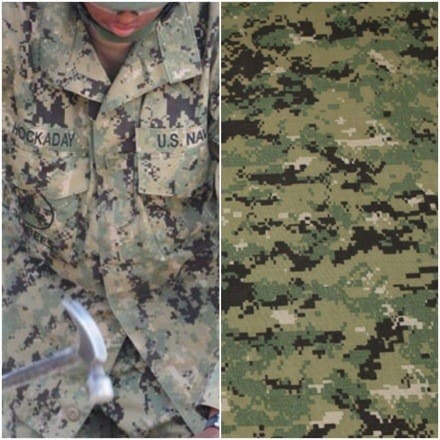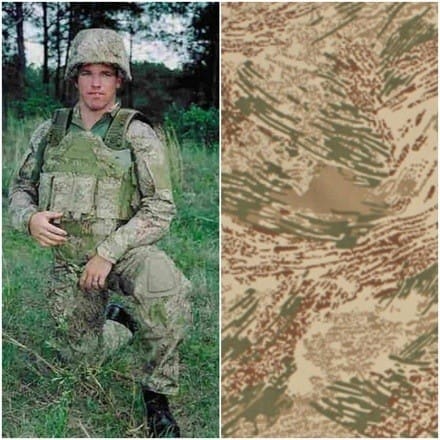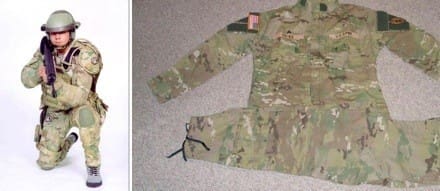On March 6th, 2012, SSD reported that the US Army had withdrawn its family of patterns from the Camouflage Improvement Effort. We published this statement from PEO Soldier:
“On Jan. 10th, the Army announced that families of camouflage patterns from one government team and four commercial vendors were selected to proceed into the next step of evaluations. As part of a cost savings strategy and as a result of initial assessments, the government submission is being removed from further consideration as a replacement to the universal camouflage pattern. This decision has been made in light of the similarity between elements of the government and one industry submission and the higher score of the industry submission during the initial evaluation. We are excited about the four vendor patterns we are going forward with. We anticipate experiencing very positive results in our field trials and more advanced computer evaluations. We will continue to work closely with our industry partners and our government team, especially in terms of research, development and evaluation. The Army conducts extensive testing to ensure we provide Soldiers with the very best clothing and equipment.”
Based on that information (and a couple of tips), we surmised that the withdrawn pattern was indeed the Scorpion originally developed for the Objective Force Warrior program. Ultimately, OFW was never fielded and developer Crye Precision went on to great success by refining the pattern into MultiCam which was ultimately chosen for use in Afghanistan by the US Army and Air Force as the Operation Enduring Freedom Camouflage Pattern (OCP). Occasionally, Natick does some work on Scorpion so it wasn’t that far of a stretch to believe that they had created an entire family of patterns from it. But as it turns out, Scorpion was only part of the story.
Now that we are a week or so away from the Army’s anticipated announcement of a completely new family of camouflage patterns on 14 June, we’d like to tell you the rest of the story.
And now for the rest of the story…
That “family” of patterns submitted by Natick for the Army Camouflage Improvement Effort wasn’t really a family at all. Originally, the plan was that Natick was going to get two families of patterns but industry balked citing unfair advantage against their three allotted patterns and it was dropped to one government and upped to four commercial patterns. As we understand it, the engineers at Natick took a look at the requirement and what would work best in each environment and entered a most unanticipated candidate considering the Army’s public assertion that it wanted a family of camouflage patterns with a common geometry and specialized colors for each environment of Woodland, Arid, Transitional and an option OCIE/PPE pattern if needed.
The government solution?
Woodland – AOR2 or similar variant
Arid – Desert All Over Brush
Transitional – Scorpion
Why the disparity? The camouflage experts at Natick analyzed previous testing as well as other data at their disposal and realized that these three patterns would perform best based on the overall requirement. One thing we do know, the team that developed the government entry was kept separate from the team that developed the evaluation strategy. They weren’t gaming the system, they were trying to offer the best solution at their disposal.
Ready to hear something else that will blow your mind? The Brookwood finalist family of patterns isn’t a true family either. If anything, you could call the individual patterns “cousins.” The geometries are similar but aren’t an exact match. Despite all of the talk, it wasn’t part of the selection criteria.
Worse yet, it shouldn’t be. Not if you want the best camouflage for each of those environments. The environments are each different and the patterns should utilize different shapes, sizes and orientations, as well as colors. Natick realized it but their entry was withdrawn. The question is, was it done to eliminate unfair competition or to conceal the common geometry shortcoming?





Can someone accidentally let us know who won?
Maybe at some other website but not here.
I think the pattern is going to be announced sometime in June.
Yeah, it even says so in the article you are commenting on.
I won, by being in the Army.
Wow, i was not expecting this.
kind of how the Canadians use a larger macropattern for their desert CADPAT vs that on the temperate CADPAT. this allows it to be effective at the longer ranges encountered in desert areas…
This is interesting but follows the baseline slides I saw a few years back at PEO. The newest and best needed to perform at or better than the baselines that Nantick decided were the best in each area. Very interesting that not much has been said about the geometries and if they could have been different. Good article SSD.
the army is going full retard… never go full retard
lol i got to remember that
Alright, I’ve tried to read through the archives and find this but I’m just not seeing it. So here is my question. Is it a possibility for the Army to pull from multiple vendors? Say desert is Brookwood, woodland is US4CES, transitional is Crye? Again, I’ve tried going through the archives on my breaks and am just not seeing anything regarding that. Based on the above article though it would suggest that’s a possibility. Which really changes the outcome from “Winner” to possibly “WinnerS”.
According to what was briefed at industry yes, but based on the solicitation, the answer is no.
Got it! Thanks!
Interesting stuff… always like hearing the behind-the-scenes stuff.
And I don’t know that a common geometry is necessary, to my (untrained, unscientific) eye, US4CES looks most effective, and it uses the same pattern (even as the ACU!) across all four pieces.
Personally, though, I think the Kryptek pattern is coolest looking. Terrible rationale for a uniform, I know, but hey… either one would be a good win, and a vast improvement over ACU for me.
Hey, SSD… what color t-shirt are soldiers going to be wearing under this new camo? Or will that be ironed out after the final one is announced? We’ve had dark brown, and sand… how about Marine green tees this time around?
“unique”… I meant “don’t know that a UNIQUE geometry is necessary…”
When I joined the Army in 85 they had these crappy brown Tshirts but OD Tees were still authorized and were higher quality so I wore those for awhile. Once they were no longer authorized I found some decent brown Tees that didn’t change color in the wash or have bacon neck.
No idea what the Army will authorize with this new family of patterns but…the average Soldier is going to be wearing the transitional pattern. All four vendor patterns share pretty much the same brown-based color palette so I’d hazard a guess that the Army is gong to stick with Sand.
Or perhaps tan 499, it seems to go with anything. I pulled that out of my ass, however.
So, transitional will be the daily wear? Has anything been mentioned about the numbers issued per Soldier yet or too early SSD?
No details.
The tanish webbing on the OCIE seems like a good color.
If the T-shirts do change will the color of the boots change too?
The Army has a foliage green t-shirt that aviators and fuelers wear. I always thought that foliage green matched better with the ACU/Multicam and now US4CES
http://www.armyg1.army.mil/hr/uniform/docs/Foliage%20Green%20t-shirt%20ALARACT%20message.pdf
I’ve always liked AF’s foliage green boots with multicam.
Coyote is better than tan. I do not like tan myself. The AF puke boots look good, but I haven’t seem them in the different environments to know. Do the different issued, or commercial, suede boots work well enough in non-arid areas?
In the interests of rapidly fielding this quickly, I hope the only change is just the pattern and patch colors. I’m hoping the Institute of Heraldry is already tracking the pattern and deciding on the patch colors, etc. (I believe that’s their lane), but probably not.
Mentioning the geometry aspect, that brings up a point. Someone mentioned it in the last camo post, do the fractal patterns possibly have a weakness by using fractal algorithms? Couldn’t sensors gain automatic pattern recognition and detect the camo easier?
As a deployed sensor on the battlefield issued at the Soldier level? By whom?
I was just thinking in general terms.
My undergrad degree was in computer engineering. The amount of processing power it would take and the resolution on the image sensor that it would require is horrendous. You’d be much better off using thermal imaging.
From an artistic point of view, it makes sense to have different pattern/geometry for each environment/terrain. If you’re in a transitional environment and it happens to be tall grass, block/bush pattern isn’t going to be effective. You’d need something with a vertical brush pattern. Realistically, you can go on forever with all the AOs and we’re not going to carry 10 uniforms everywhere we go. However, I did like the reversible camouflage concept.
Interesting story about the Natick deal–I think it would have been an goatscrew on aesthetic AND functional level.
I can’t recall seeing anything other than swatches of the Brookwood, but that pattern did prompt me to consider the geometric “cousin” concept. Yeah, maybe I’m getting too wrapped around the axle on this. I’m now less inclined than ever to try to surmise a winner.
“environments are each different and the patterns should utilize different shapes, sizes and orientations, as well as colors.”
This is generally true because of the way that most patterns have historicall been designed to imitate some part of the terrain that they are designed for: think “jungle leaf” or “desert rocks”. The Canadians did it with CADPAT as well because of the small(ish) size of the color blocks they used in CADPAT (TW) and because of its horizontal pattern orientation.
But when I started working with the PenCott patterns I realized that a complex pattern geometry can be designed in such a way that it can actually be used successfully for multiple environments by changing the colors, the number of colors and the orientation of the colors to each other.
I believe PenCott would perform very well, too bad it’s not a finalist.
Although I haven’t seen enough of the Brookwood entries to know for sure, I do not know how they won over Pencott. Pencott looks like it works really well.
The PenCott submissions were disqualified on the grounds that the patterns were available commercially, that they weren’t uniquely for the Army, and because a foreign (British) citizen was the designer.
At Army Day this question was asked about Foreign Developed designs – as I am Canadian, the Army Lawyer said that citizenship of the Camouflage designer would not be an issue, and US4CES is in the finals.
As much as I want the most effective possible pattern for every environment, there is something to be said for constant geometry. It makes IFF easier.
I didn’t see it mentioned specifically in the article so I figured I would ask, what was the OCIE pattern for the Government submission? It seems to me that the biggest down fall of NOT having a common geometry between the patterns is finding an OCIE pattern that works across all three of them. So I would be curious how they dealt with that, or if that was part of the reason they dropped their submission?
According to Guy Cramer, they tested all the patterns with both matching PPE and solid colored PPE. He also made it sound like the government submission got tested with Multicam PPE.
I don’t know what the Government used for their OCIE submission. For the 2009 study they tested a number of different OCIE/PPE colors and patterns.
i have a feeling ads is gonna win just because it looks similar to marpat …
Has any work or research been done on the material these patterns are being printed on? I recently saw a photo of kryptek in the woods and it looked like it was printed on something that had just a little more sheen than the standard nylon 50/50 fabric used in most uniforms(I think that’s what they use). Anyhow, it seemed to reflect the cascading light more naturally than what you would expect from a standard fabric. Just a thought; foliage can be reflective to a point.
The Kryptek hunting clothes are made from polyester, which has more sheen, but not NIR compliant. The Kryptek military/leo clothing is (will be) made from 50/50 nyco ripstop and uses NIR compliant dyes. The colors are a little more subdued and not as reflective as the hunting line. Check out Vertx’s website to see some good examples of all the Kryptek patterns in mil-spec materials. Or, go to Kryptek’s site and look at the ‘order fabric’ option. Cool stuff!
More pics available at tacticalgear.com, la police gear, afmo, etc. Just search Kryptek at one of these sites.
Just one more thing. The pants and caps are available now, but the shirts won’t be available until June 14th or so.
The fact that we will have to keep the ACU cut and not switch to the MCUU cut blows!
I’ve always been a fan of the MCUU cut, but I think the money is in the NWU II & III cut. Just looking at the overall quality and thought put into it, its leaps and bounds and obviously a decade beyond the MCUU and ACUs. I wouldn’t doubt when the branches go to a streamline “cut” across the board, this is what they’ll use…whenever that’ll be.
SSD, thanks for keeping the articles coming
What is the government “family” still in the running? Is it AOR2, Multicam, AOR1?
The isn’t a Government family in the running. It was withdrawn. Several current issue patterns are being used as baseline (AOR among them) and as of the down select, all of the four finalist families had outperformed baseline.
Thanks, that clears up my confusion. I didn’t realize there was a distinction between the government submission and the baseline patterns.
It was Multicam.
I see the AOR IIs around a lot now. I always thought they were more of a transitional coloration. The pattern is also more vertical. I am not sure if they switched it to vertical for a better performance reason, or just to differentiate enough from MARPAT so the Marines would give in and not trap the Navy’s use like they did for AOR I.
I agree with you about AOR2 being transitional. I’ve found it has worked really well for me in the hills. But apparently it is currently the best woodland pattern according to the army.
Not for long!
there actually is a transitional AOR: http://www.octactical.com/unknowndg.jpg
Aside from the pattern change. Has anyone heard anything about buttons on the sleeve cuffs or removing the zipper?
No, and nothing is going to be done. If you want some insight into that, look back in the archives to summer of 09 for a story on improving the ACU.
They are selling the ACUs with buttons on the sleeve cuffs at clothing and sales now. I’m just hoping it transfers over. I can sew a button, but can’t fix hook/pile.
ADS will win. It has the common family design (brand ID, which the Army loves… ie the Army brand going on everything nowadays), the 4th camo for all of the gear (limiting costs and logistic issues), and an already established distrobution network. Additionally, it probably did better against NVGs and IR detection, which was likely the deciding factor in “best pattern”.
The ACU will stay the same (with the updated buttons on the pants) due to costs and not wanting to admit that it is another Army failure with uniforms.
It’s just a shame that we have to wait.
Any news on how long it will take to hit uniform and sales/ authroized wear?